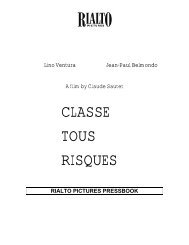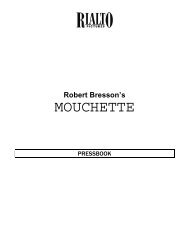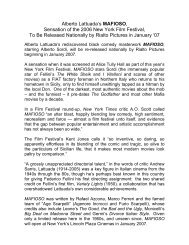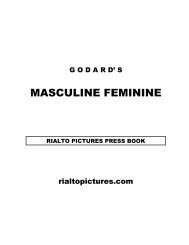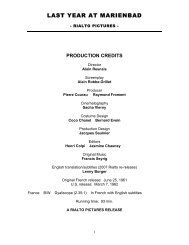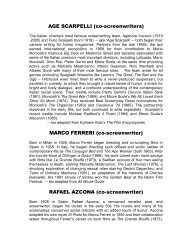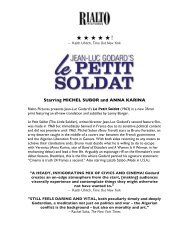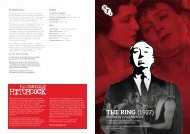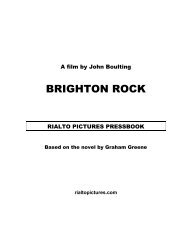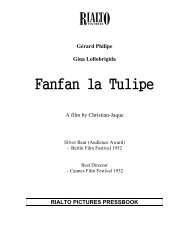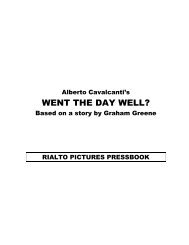Jean-Luc Godard's Two Or Three Things I Know ... - Rialto Pictures
Jean-Luc Godard's Two Or Three Things I Know ... - Rialto Pictures
Jean-Luc Godard's Two Or Three Things I Know ... - Rialto Pictures
Create successful ePaper yourself
Turn your PDF publications into a flip-book with our unique Google optimized e-Paper software.
stars'. The economic reasons for this, as Godard explained in an interview, are<br />
that most of these women have been forcibly re-located in these dreary buildings<br />
outside the city. Their flats are modem, with central heating and all modem<br />
conveniences, but they are not allowed to bring with them their old furniture—for<br />
fear of woodworm—and so they have the initial expense of refurnishing the<br />
house. Then there is the cost of moving, charges for connecting gas and light,<br />
and furthermore many of them, carried away by their new-found luxury, run up<br />
heavy bills for gas and electricity. From the very beginning they are in debt.<br />
Faced with the necessity of paying off these debts, and more important, affording<br />
all the luxuries with which our consumer society tempts us, many of these<br />
women go into Paris (some once a week, some only at the difficult end of the<br />
month), to prostitute themselves. Returning home with a full grocery bag, they<br />
are much appreciated for their 'clever management' by their unsuspecting—or<br />
complaisant—husbands.<br />
This is the pretext for the film, and it also gives it a basic structure: twenty-four<br />
hours in the day of one of these 'shooting stars', an attractive young housewife<br />
(played by Marina Vlady) who lives with her garage mechanic husband and their<br />
two children in a housing complex. The film begins one evening and ends the<br />
next, during which time she has spent the day in Paris. . . .<br />
His model, in some respects, has been Francis Ponge, a French poet who began<br />
during the last war to write little poems in prose which are neither more nor less<br />
than the descriptions of objects….When Godard shows us for what seems like<br />
two or three minutes a shot of a coffee-cup seen from above, with the bubbles<br />
first gradually separating, then re-forming into a circle in the centre, then<br />
redispersing, one feels one is experiencing something much more important than<br />
at first sight it seems to be….The music of the spheres? The movement of<br />
molecules?<br />
The many shots of cranes, steam shovels, dump trucks are of course easier to<br />
'justify'—they are what is physically transforming the new Paris, and the way in<br />
which they tower over the old Paris dominating the life of the inhabitants is<br />
thematically quite clear. So, too, the shots of consumer products, which…are<br />
meant to figure the role of advertising in our lives. But the coffee-cup, and<br />
another extraordinarily long-held shot of the end of a burning cigarette, carry<br />
more premonitory weight than one would have thought possible….<br />
Before going on to <strong>Godard's</strong> use of subjective descriptions, one must point out<br />
that the characters of the film are also seen as objects:<br />
"It is 4:45.<br />
Should I speak of Juliette or of these leaves?<br />
Since it is impossible, in any case, really to do both together, let's say that both<br />
tremble gently in this beginning of the end of an October afternoon."<br />
8



